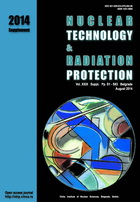
SET-UP AND FIRST OPERATION OF A PLASMA OVEN FOR TREATMENT OF LOW LEVEL RADIOACTIVE WASTES

Vol.
XXIX, Suppl., Pp. S1-S63
August 2014
UDC 621.039+614.876:504.06
ISSN 1451-3994
Pages: S47-S51
Authors: Frederik Nachtrodt, Wolfgang Tietsch, Domiziano Mostacci, and Ulrich W. Scherer
Abstract
An experimental device for plasma treatment of low and intermediate level radioactive waste was built and tested in several design variations. The laboratory device is designed with the intention to study the general effects and difficulties in a plasma incineration set-up for the further future development of a larger scale pilot plant. The key part of the device consists of a novel microwave plasma torch driven by 200 W electric power, and operating at atmospheric pressure. It is a specific design characteristic of the torch that a high peak temperature can be reached with a low power input compared to other plasma torches. Experiments have been carried out to analyze the effect of the plasma on materials typical for operational low-level wastes. In some preliminary cold tests the behavior of stable volatile species e. g., caesium was investigated by TXRF measurements of material collected from the oven walls and the filtered off-gas. The results help in improving and scaling up the existing design and in understanding the effects for a pilot plant, especially for the off-gas collection and treatment.
Key words: low level waste, plasma technology, radioactive waste treatment
FULL PAPER IN PDF FORMAT (451 KB)